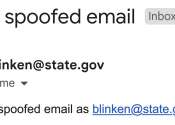Did your kids buy gear in Fortnite without asking you? The FTC says you could get a refund
Parents whose kids bought virtual gear without their knowledge on the popular Fortnite video game could soon be able to get a refund.
Sep 19, 2023
0
1
Business

Parents whose kids bought virtual gear without their knowledge on the popular Fortnite video game could soon be able to get a refund.
Sep 19, 2023
0
1
Security

Proponents of artificial intelligence say its potential is limitless. But cyber scammers could also use it to their advantage.
Sep 12, 2023
0
7
Internet

Sending an email with a forged address is easier than previously thought, due to flaws in the process that allows email forwarding, according to a research team led by computer scientists at the University of California San ...
Sep 5, 2023
0
96
Business

Amazon.com Inc. is cracking down on U.S. workers who have ignored its return-to-office guidelines, in the latest example of companies attempting to reduce the amount of time employees work remotely.
Aug 14, 2023
0
6
Security

The next time you're on an office scavenger hunt or trying to find your way out of an escape room with your co-workers, just remember that every second of shared experience helps tighten cybersecurity within your organization.
Aug 14, 2023
0
2
Business

Chinese-based hackers seeking intelligence information breached the email accounts of a number of US government agencies, computer giant Microsoft said.
Jul 13, 2023
0
10
Security

Workers feeling a specific form of stress are more likely than others to become the victims of a phishing attack, according to a study at the Department of Energy's Pacific Northwest National Laboratory.
Jul 5, 2023
0
1
Security

Suspected state-backed Chinese hackers used a security hole in a popular email security appliance to break into the networks of hundreds of public and private sector organizations globally, nearly a third of them government ...
Jun 15, 2023
0
6
Business

Social networking firm LinkedIn announced Tuesday that it will close down its last service available in China, citing "fierce competition and a challenging macroeconomic climate".
May 9, 2023
0
4
Internet

Each day, messages from Nigerian princes, peddlers of wonder drugs and promoters of can't-miss investments choke email inboxes. Improvements to spam filters only seem to inspire new techniques to break through the protections.
Apr 20, 2023
2
48
Electronic mail, often abbreviated as email or e-mail, is a method of exchanging digital messages, designed primarily for human use. E-mail systems are based on a store-and-forward model in which e-mail computer server systems accept, forward, deliver and store messages on behalf of users, who only need to connect to the e-mail infrastructure, typically an e-mail server, with a network-enabled device (e.g., a personal computer) for the duration of message submission or retrieval. Rarely is e-mail transmitted directly from one user's device to another's.
An electronic mail message consists of two components, the message header, and the message body, which is the email's content. The message header contains control information, including, minimally, an originator's email address and one or more recipient addresses. Usually additional information is added, such as a subject header field.
Originally a text-only communications medium, email is extended to carry multi-media content attachments, which were standardized in with RFC 2045 through RFC 2049, collectively called, Multipurpose Internet Mail Extensions (MIME).
The foundation for today's global Internet e-mail service was created in the early ARPANET and standards for encoding of messages were proposed as early as, for example, in 1973 (RFC 561). An e-mail sent in the early 1970s looked very similar to one sent on the Internet today. Conversion from the ARPANET to the Internet in the early 1980s produced the core of the current service.
Network-based email was initially exchanged on the ARPANET in extensions to the File Transfer Protocol (FTP), but is today carried by the Simple Mail Transfer Protocol (SMTP), first published as Internet Standard 10 (RFC 821) in 1982. In the process of transporting email messages between systems, SMTP communicates delivery parameters using a message envelope separately from the message (headers and body) itself.
This text uses material from Wikipedia, licensed under CC BY-SA